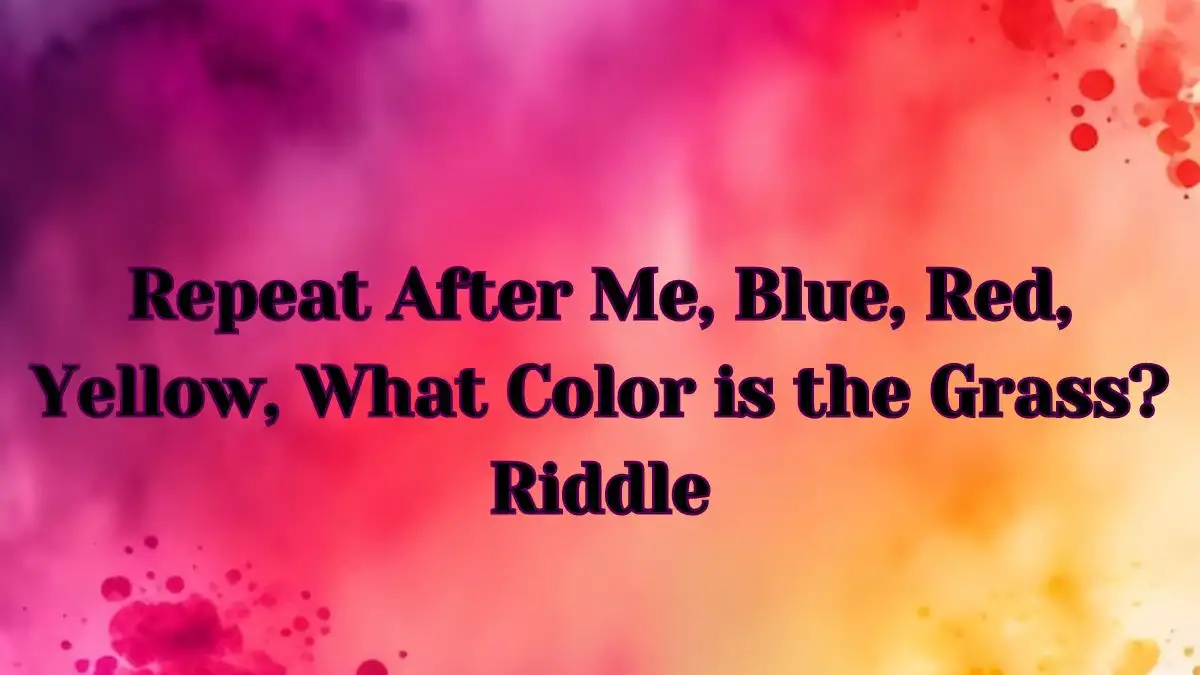Repeat After Me, Blue, Red, Yellow, What Color is the Grass? Riddle Answer Solved
by Priyanka P
Updated Nov 23, 2023

Repeat After Me, Blue, Red, Yellow, What Color is the Grass? Riddle
In this intriguing riddle, participants are prompted to repeat a sequence of colors—blue, red, yellow—and then posed a question about the color of the grass. The key lies not in the expected response related to colors but in the shift to a different type of answer.
The riddle relies on a clever play on words, creating a mental diversion that can catch people off guard. It challenges the assumption that the answer should be another color, leading participants to reconsider the question and respond in a way that aligns with the established pattern. It's a delightful example of how language and expectations can be manipulated to create a surprising twist in the form of a solution.
Immerse yourself in the world of riddles on Fresherslive, where each challenge is a testament to the art of mental gymnastics. Our page’s collection of riddles is a playground for the intellect, a realm where curiosity and problem-solving converge.
Repeat After Me, Blue, Red, Yellow, What Color is the Grass? Riddle Explained
This riddle cleverly tricks participants into anticipating a color-related answer, given the sequence of "Blue, Red, Yellow." However, the twist lies in the question that follows: "What color is the grass?" Instead of expecting another color, the answer is embedded in the instruction itself. The participants are meant to repeat the phrase "What color is the grass?" rather than stating a specific color.
The riddle exploits the assumption that the answer should align with the established pattern of colors, surprising those attempting to solve it. It's a playful manipulation of language and expectations, showcasing how a simple linguistic diversion can lead to an unexpected and humorous solution.
What is Riddle?
Riddle is a type of puzzle or word game that presents a mystery or question in a clever and often cryptic way. It typically involves a statement, question, or phrase with a hidden or double meaning, challenging the person to figure it out. Riddles come in various forms, such as enigmas, which require creative thinking and metaphorical interpretation, and conundra, which rely on wordplay or puns in the question or answer.
Riddles have been part of human culture for centuries and can be found in many different cultures worldwide. They are like brain teasers, designed to engage the mind and encourage problem-solving. People enjoy riddles for the mental challenge and the satisfaction of unraveling the hidden meaning. Riddles often serve as a form of entertainment and intellectual exercise, and they can be a fun way to test and expand one's thinking abilities
Advantages of Solving Riddle
Solving riddles offers several advantages, making it an enjoyable and beneficial activity:
Mental Stimulation:
Riddles require critical thinking, creativity, and problem-solving skills. When you solve a riddle, you exercise your brain, keeping it active and sharp.
Enhanced Problem-Solving Skills:
Riddles often present complex challenges in a concise format. Solving them hones your ability to analyze information, think logically, and find innovative solutions.
Improved Language Skills:
Riddles play with words, encouraging better vocabulary, wordplay, and linguistic comprehension. They can be an enjoyable way to learn new words and phrases.
Boosted Confidence:
Successfully solving a challenging riddle can be incredibly satisfying, leading to increased self-confidence and a sense of accomplishment.
Entertainment:
Riddles are a source of entertainment and amusement, whether solved individually or as part of a group. They can be a fun way to pass the time.
Social Interaction:
Riddles often prompt discussions and interactions among people trying to solve them together, fostering teamwork and communication.
Cultural Understanding:
Riddles are found in many cultures, and solving riddles from different parts of the world can offer insights into diverse perspectives and traditions.
Creativity:
Riddles encourage thinking "outside the box" and inspire creative solutions to problems.
Repeat After Me, Blue, Red, Yellow, What Color is the Grass? Riddle - FAQs
A riddle is a clever and often cryptic puzzle or word game that presents a mystery or question, challenging individuals to decipher its hidden meaning.
Solving riddles offers both mental stimulation and a sense of accomplishment, providing a playful yet beneficial way to exercise critical thinking and problem-solving skills.
Riddles play with words, promoting better vocabulary, wordplay, and linguistic comprehension, making them an enjoyable tool for learning new words and phrases.
Yes, successfully solving a challenging riddle can lead to increased self-confidence, as it provides a tangible sense of achievement and mastery over complex problems.
Riddles often prompt discussions and interactions among people attempting to solve them together, fostering teamwork and communication in a shared intellectual pursuit.







